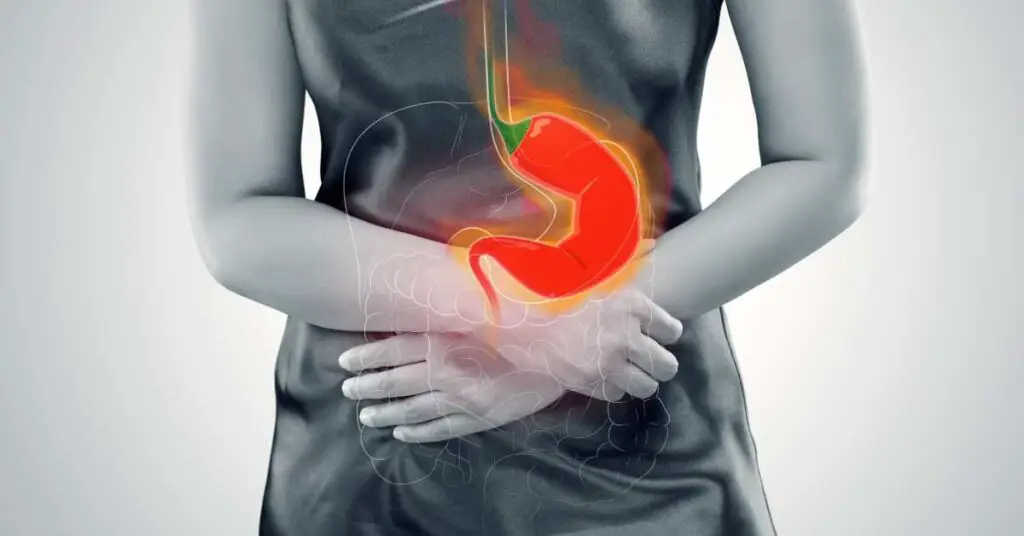Acid reflux, also known as gastroesophageal reflux disease (GERD), is a common digestive disorder that affects millions of people around the world. Symptoms can range from mild to severe and include heartburn, nausea, regurgitation of stomach acid or food, sore throat, chest pain and coughing. While there are many treatments available for those suffering from acid reflux, one option gaining popularity is the use of meditation techniques to help reduce symptoms.
In this article we will discuss how meditation can be used to manage acid reflux and improve overall wellbeing.
Yes, meditation can help reduce the symptoms of acid reflux. Research has shown that relaxation techniques such as yoga, deep breathing and meditation can have a calming effect on the digestive system, which helps to reduce the occurrence of acid reflux and its associated symptoms.
Additionally, research suggests that stress is also linked to an increased risk of acid reflux. Therefore, engaging in regular relaxation practices like meditation may help to decrease stress levels and ultimately prevent or lessen GERD symptoms.

What are acid reflux, its symptoms, and its causes?
Acid reflux, also known as gastroesophageal reflux disease (GERD), is a digestive disorder that affects millions of people worldwide. It is characterized by a backflow of stomach acid or food up into the esophagus, resulting in the typical symptoms of heartburn, nausea, regurgitation of stomach acid or food, sore throat, chest pain, and coughing.
GERD is caused by a malfunction in the lower esophageal sphincter (LES) which normally helps to keep acidic contents of the stomach from rising up into the esophagus.
Common causes of acid reflux include diet, lifestyle factors like being overweight or smoking habits, certain medications, and conditions such as pregnancy, hiatal hernia, or a weakened immune system.
How can meditation help reduce the symptoms of acid reflux?
Meditation can help reduce the symptoms of acid reflux in several ways.
1. Meditation helps to calm the digestive system which can reduce the occurrence of acid reflux and its associated symptoms.
2. Research suggests that stress is linked to an increased risk of acid reflux, so by engaging in regular relaxation practices like meditation, you may be able to decrease your stress levels and lessen GERD symptoms.
3. Meditation increases your awareness of your body, enabling you to recognize triggers that cause acid reflux so you can make changes in order to avoid them or manage them more effectively if they do occur.
4. Meditation creates a sense of peace and well-being which can help reduce anxiety related to GERD symptoms and improve overall health and quality of life for those with this condition .
5. Through meditation, you can also gain greater insight into how best to manage GERD through lifestyle modifications such as dietary changes or exercise habits that may help alleviate symptoms over time .
Are there any meditation positions to help with acid reflux?
Yes, there are certain meditation positions that can help with acid reflux. Sitting upright in chair pose with the spine straight and tall is one of the most beneficial poses for those suffering from GERD. This posture helps to open up the abdominal area, which can reduce stress on the digestive system and therefore help to ease symptoms of acid reflux.
Another useful meditation position for those dealing with GERD is “supine mountain” pose. In this pose, you lie on your back in a comfortable position with your knees bent and feet together and flat on the floor. This helps to open up and relax the stomach muscles which can reduce pressure in the abdomen, allowing for better digestion and relief from acid reflux symptoms.
Other beneficial positions include: corpse pose (also known as savasana), where you lie still on your back; bridge pose, where you lay on your back with your knees bent and feet flat on the floor while lifting your hips off the ground; seated twist pose; cow face pose; wide-legged forward bend; reclining bound angle pose; legs up wall pose (where you lay down and prop yourself up against a wall); half lord of fishes posture; cobra posture; seated forward bend; cat-cow stretch (where you alternate between arching your back up like a cat, then lowering it down like a cow).
It is important to note that while certain yoga poses may be beneficial for relieving acid reflux symptoms, not all poses are appropriate or safe for people who suffer from GERD . Therefore it is best to speak to your doctor or health practitioner before attempting any of these postures. Additionally, always practice mindful breathing during each session as this helps to center both mind and body which can also provide relief from GERD symptoms.
What are the most effective meditation practices for relieving acid reflux?
The most effective meditation practices for relieving acid reflux symptoms involve slow, mindful breathing. Diaphragmatic breathing (also known as abdominal or belly breathing) is particularly beneficial because it encourages deep, even breaths that help to relax the body and reduce stress levels.
Additionally, guided meditations with visualizations can be useful in helping to calm the digestive system and alleviate GERD symptoms. Other helpful practices include mindfulness meditation and yoga nidra (a type of yogic sleep). Practicing these techniques on a regular basis can help to keep GERD symptoms under control and improve overall health and quality of life.
In conclusion, meditation has been shown to be an effective way of calming the digestive system and reducing acid reflux symptoms. Through mindful breathing and other relaxation techniques such as guided meditations and visualizations, you can gain greater insight into how best to manage GERD through lifestyle modifications.
Additionally, certain yoga poses can also provide relief from acid reflux symptoms. Therefore, if you suffer from GERD, meditation may be an effective way of managing your condition.
Mindful breathing exercise for acid reflux:
1. Begin by finding a comfortable position either sitting or lying down
2. Close your eyes and focus on the sensation of your breath moving in and out of the body
3. Take slow, deep breaths in through your nose expanding the belly and then slowly exhaling out through the mouth
4. Whenever thoughts come up in your mind, simply acknowledge them but don’t judge or engage with them
5. With each breath focus on the sensation of the air traveling in and out of your body
6. As you continue to breathe, imagine that each breath is a wave of relaxation washing over your entire body from head to toe
7. When you are finished, take a few moments to sit or lie quietly before slowly opening your eyes and bringing yourself back into the present moment.
By practicing this exercise regularly, it can help to reduce stress levels which in turn can have a beneficial effect on GERD symptoms.
Additionally, it also provides an opportunity for reflection and insight into how best to manage acid reflux through lifestyle modifications.
What are the challenges they encounter during the meditation process?
One of the main challenges people may encounter when practicing meditation for acid reflux is difficulty focusing on their breathing. This can be especially difficult for those who are new to meditation and have not yet developed a regular practice. Additionally, it is easy to get distracted by thoughts, worries and other mental chatter. It can also be difficult to stay in one position for a long period of time if you suffer from GERD symptoms such as discomfort or pain in the chest area.
For many people, particularly those dealing with anxiety or depression, simply sitting still and being present can be extremely challenging. As they become more aware of their physical sensations and emotions, they may experience feelings of unease or discomfort. This can make it even harder to concentrate on their breath or keep up a regular practice.
Additionally, there are some specific postures that may not be suitable for everyone due to physical limitations or medical conditions. If this is the case, it’s important to talk to your doctor or health practitioner before attempting any type of yoga pose that may trigger GERD symptoms.
Finally, it can take a lot of dedication and discipline to maintain a regular meditation practice over an extended period of time. Though there are many benefits associated with consistency, it can be difficult for those with busy lives to carve out time each day for mindful breathing exercises or other relaxation techniques. Therefore it is important to create realistic goals and expectations when starting out with meditation so that you don’t become discouraged if progress is slow at first.
Is there any risk to practicing meditation, and how can that risk be mitigated?
Although meditation can be a beneficial tool for managing acid reflux, it is important to keep in mind that it is not a cure and should be used in conjunction with other lifestyle modifications such as diet and exercise.
Additionally, it is important to consult with your doctor or health practitioner before attempting any type of yoga pose or relaxation technique as certain poses may trigger GERD symptoms.
When practicing meditation, there are some risks associated with the process which should be taken into consideration. For example, if you are prone to anxiety or depression then suddenly focusing on breath and body awareness may trigger feelings of unease or discomfort.
Additionally, if you suffer from physical limitations or have an underlying medical condition then certain postures or movements may not be suitable for your particular needs. Therefore, it is important to make sure you are comfortable physically before attempting any type of meditation practice.
In order to mitigate these risks when practicing meditation for acid reflux, it is important to start slowly and build up gradually over time. Begin by focusing your attention on each full breath and only move your body when you feel comfortable doing so. If thoughts come up in your mind during the process simply acknowledge them but don’t judge or engage with them too deeply. If any physical sensations become uncomfortable then take a few moments to rest before continuing on with the practice.
Additionally, make sure you have realistic expectations when starting out with meditation as progress can take time and require dedication and discipline in order to maintain a regular practice over an extended period of time. Finally, remember that although mindfulness techniques can provide insight into how best to manage GERD through lifestyle modifications, they should always be used in conjunction with other treatments recommended by your doctor or healthcare provider.
Conclusion
Acid reflux can be a difficult condition to manage, but with the right lifestyle modifications and relaxation techniques, it is possible to find relief. Meditation can be an effective tool for managing acid reflux symptoms by providing insight into how best to cope with physical sensations and emotions that arise during the process. However, when beginning a meditation practice it is important to consult with your doctor or health practitioner first and keep in mind that progress can take time and may require dedication and discipline in order to maintain a regular practice over an extended period of time.
By following these guidelines you can use mindfulness techniques safely and effectively as part of your overall treatment plan for GERD.




